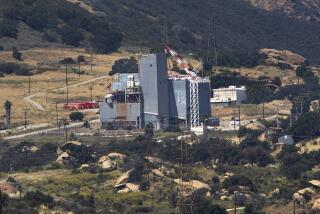An Unblinking Eye on Iraqi Factories : Germ-war issue demands ongoing U.N. scrutiny
- Share via
An Iraqi regime that has spent the better part of five years hiding the full extent of its unconventional weapons programs from U.N. inspectors now professes to have adopted a come-clean approach and swears it is telling all. Fully truthful or not--and with Saddam Hussein’s government it’s always safer to assume deception--the revelations from Baghdad are chilling.
Iraq now admits to having made what one U.N. expert describes as a “very huge investment” in viral and plant-based toxins tailored for biological warfare. These weapons, Baghdad claims, were all destroyed after Iraq was defeated in 1991 by the American-led coalition that liberated Kuwait. U.N. inspectors are trying to verify that claim, no easy task given the opportunities Iraq has had to hide the hard-to-detect material. But beyond immediate efforts at verification, it’s now clear that the international community must also insist on a permanent, on-site watch at any Iraqi facilities that can produce either chemical or biological warfare agents.
Iraq has provided U.N. officials with data indicating that its biological weapons effort employed up to 150 scientists and technicians, not the 10 earlier acknowledged; that the effort was well under way during the eight-year war it fought with Iran in the 1980s, and that the program was intensified beginning in July, 1990, the month before Iraq invaded Kuwait.
Besides developing weapons for transmitting anthrax and botulism, Iraq now concedes it worked on a spectrum of agents, ranging from viruses that could blind through hemorrhagic conjunctivitis to gangrene-causing bacteria to a deadly fungi-produced mycotoxin known as yellow rain. Additionally, Iraq made a toxin called ricin, derived from castor oil beans, at a facility that is still in operation, supposedly making brake fluid. Here, as with some of the products used in chemical weapons, is another example of a potential dual-use facility--and here is the reason why there can be no substitute for on-site inspections of suspect plants.
The nature of the Iraqi weapons and some of the dispersal systems developed for them make clear that potential targets included not just enemy forces in the field but also civilian populations. One likely target, as officials told Times correspondent Robin Wright, was Israel. It does not take extensive imagination to envisage how that country, an unacknowledged nuclear power, might have responded to such an atrocity. The vital need now is to make sure Iraq doesn’t secretly regain the capacity for mounting such attacks against anyone. That means watching it with the same caution, and with as much trust, as one would watch a coiled rattlesnake.
More to Read
Inside the business of entertainment
The Wide Shot brings you news, analysis and insights on everything from streaming wars to production — and what it all means for the future.
You may occasionally receive promotional content from the Los Angeles Times.










